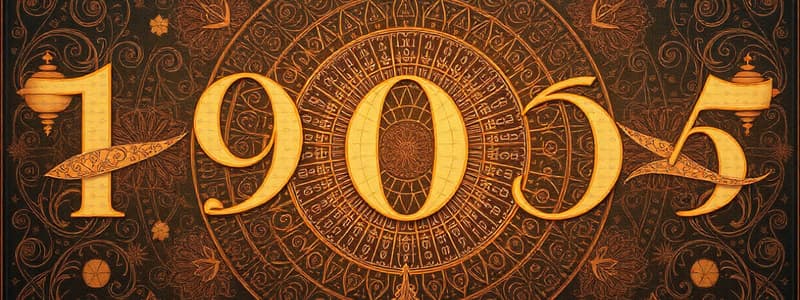Podcast
Questions and Answers
What is a number system primarily used for?
What is a number system primarily used for?
- Creating graphical illustrations
- Representing numbers using digits or symbols (correct)
- Converting letters to numbers
- Calculating geometric shapes
Which of the following is NOT a main type of number system?
Which of the following is NOT a main type of number system?
- Octal number system
- Binary number system
- Hexadecimal number system
- Fractional number system (correct)
How many digits does the octal number system use?
How many digits does the octal number system use?
- 7 digits
- 8 digits (correct)
- 6 digits
- 9 digits
What is the base of the decimal number system?
What is the base of the decimal number system?
Which number represents a value in the binary number system?
Which number represents a value in the binary number system?
In converting the binary number (100111) to decimal, what is the first step?
In converting the binary number (100111) to decimal, what is the first step?
When converting binary digits to decimal, what is the exponent for the rightmost digit?
When converting binary digits to decimal, what is the exponent for the rightmost digit?
Which step follows multiplying each digit by its exponent in binary to decimal conversion?
Which step follows multiplying each digit by its exponent in binary to decimal conversion?
What is the value of the binary number (111111) when converted to decimal?
What is the value of the binary number (111111) when converted to decimal?
What is one advantage of using the octal number system?
What is one advantage of using the octal number system?
Flashcards are hidden until you start studying
Study Notes
Definition of Number Systems
- A number system is a consistent way of representing numbers using digits or symbols.
- The value of each digit in a number is determined by its position and the base of the number system.
- Number systems are used for converting between different representations of numbers.
- Number systems help represent numbers using a limited set of symbols.
Types of Number Systems
- There are four main types of number systems:
- Binary (Base 2)
- Octal (Base 8)
- Decimal (Base 10)
- Hexadecimal (Base 16)
Octal Number System
- Uses eight digits: 0, 1, 2, 3, 4, 5, 6, 7.
- Has a base of 8.
- Has fewer digits compared to other systems, resulting in fewer computational errors.
- Examples: 358, 9238, 14183588
Decimal Number System
- Uses ten digits: 0, 1, 2, 3, 4, 5, 6, 7, 8, 9.
- Has a base of 10.
- Is the system used in everyday life.
- Numbers without a specified base are assumed to be decimal (base 10).
- Examples: 72310, 524710, 3210, 983710
Converting Binary to Decimal
- Step 1: Identify the base of the binary number.
- Step 2: Multiply each digit in the binary number by the corresponding power of 2, starting from the rightmost digit with an exponent of 0 and increasing by 1 for each position to the left.
- Step 3: Add the results from Step 2 to obtain the decimal equivalent.
Conversion Examples
- Example 1: Converting (100111)2 to decimal:
- (1 × 2^5) + (0 × 2^4) + (0 × 2^3) + (1 × 2^2) + (1 × 2^1) + (1 × 2^0) = 32 + 0 + 0 + 4 + 2 + 1 = 39
- Example 2: Converting (111111)2 to decimal:
- (1 × 2^5) + (1 × 2^4) + (1 × 2^3) + (1 × 2^2) + (1 × 2^1) + (1 × 2^0) = 32 + 16 + 8 + 4 + 2 + 1 = 63
Studying That Suits You
Use AI to generate personalized quizzes and flashcards to suit your learning preferences.




